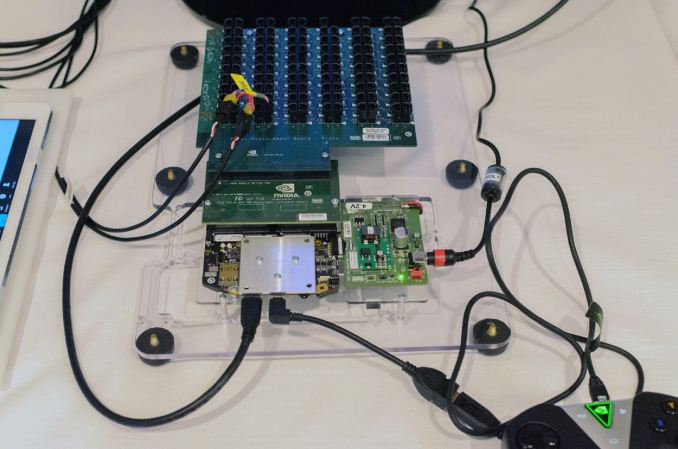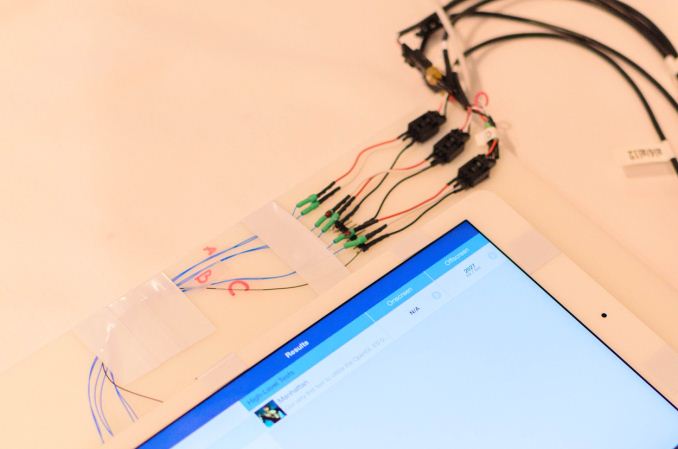NVIDIA Tegra X1 Preview & Architecture Analysis
by Joshua Ho & Ryan Smith on January 5, 2015 1:00 AM EST- Posted in
- SoCs
- Arm
- Project Denver
- Mobile
- 20nm
- GPUs
- Tablets
- NVIDIA
- Cortex A57
- Tegra X1
GPU Performance Benchmarks
As part of today’s announcement of the Tegra X1, NVIDIA also gave us a short opportunity to benchmark the X1 reference platform under controlled circumstances. In this case NVIDIA had several reference platforms plugged in and running, pre-loaded with various benchmark applications. The reference platforms themselves had a simple heatspreader mounted on them, intended to replicate the ~5W heat dissipation capabilities of a tablet.
The purpose of this demonstration was two-fold. First to showcase that X1 was up and running and capable of NVIDIA’s promised features. The second reason was to showcase the strong GPU performance of the platform. Meanwhile NVIDIA also had an iPad Air 2 on hand for power testing, running Apple’s latest and greatest SoC, the A8X. NVIDIA has made it clear that they consider Apple the SoC manufacturer to beat right now, as A8X’s PowerVR GX6850 GPU is the fastest among the currently shipping SoCs.
It goes without saying that the results should be taken with an appropriate grain of salt until we can get Tegra X1 back to our labs. However we have seen all of the testing first-hand and as best as we can tell NVIDIA’s tests were sincere.
| NVIDIA Tegra X1 Controlled Benchmarks | |||||
| Benchmark | A8X (AT) | K1 (AT) | X1 (NV) | ||
| BaseMark X 1.1 Dunes (Offscreen) | 40.2fps | 36.3fps | 56.9fps | ||
| 3DMark 1.2 Unlimited (Graphics Score) | 31781 | 36688 | 58448 | ||
| GFXBench 3.0 Manhattan 1080p (Offscreen) | 32.6fps | 31.7fps | 63.6fps | ||
For benchmarking NVIDIA had BaseMark X 1.1, 3DMark Unlimited 1.2 and GFXBench 3.0 up and running. Our X1 numbers come from the benchmarks we ran as part of NVIDIA’s controlled test, meanwhile the A8X and K1 numbers come from our Mobile Bench.
NVIDIA’s stated goal with X1 is to (roughly) double K1’s GPU performance, and while these controlled benchmarks for the most part don’t make it quite that far, X1 is still a significant improvement over K1. NVIDIA does meet their goal under Manhattan, where performance is almost exactly doubled, meanwhile 3DMark and BaseMark X increased by 59% and 56% respectively.
Finally, for power testing NVIDIA had an X1 reference platform and an iPad Air 2 rigged to measure the power consumption from the devices’ respective GPU power rails. The purpose of this test was to showcase that thanks to X1’s energy optimizations that X1 is capable of delivering the same GPU performance as the A8X GPU while drawing significantly less power; in other words that X1’s GPU is more efficient than A8X’s GX6850. Now to be clear here these are just GPU power measurements and not total platform power measurements, so this won’t account for CPU differences (e.g. A57 versus Enhanced Cyclone) or the power impact of LPDDR4.
Top: Tegra X1 Reference Platform. Bottom: iPad Air 2
For power testing NVIDIA ran Manhattan 1080p (offscreen) with X1’s GPU underclocked to match the performance of the A8X at roughly 33fps. Pictured below are the average power consumption (in watts) for the X1 and A8X respectively.
NVIDIA’s tools show the X1’s GPU averages 1.51W over the run of Manhattan. Meanwhile the A8X’s GPU averages 2.67W, over a watt more for otherwise equal performance. This test is especially notable since both SoCs are manufactured on the same TSMC 20nm SoC process, which means that any performance differences between the two devices are solely a function of energy efficiency.
There are a number of other variables we’ll ultimately need to take into account here, including clockspeeds, relative die area of the GPU, and total platform power consumption. But assuming NVIDIA’s numbers hold up in final devices, X1’s GPU is looking very good out of the gate – at least when tuned for power over performance.














194 Comments
View All Comments
kron123456789 - Monday, January 5, 2015 - link
If he still belives in android gaming, Nvidia will announce the new Shield Portable at CES or MWC.techconc - Monday, January 5, 2015 - link
Casual games will always be more popular than the more hard core type of games. That said, there are plenty of mobile games that push the system hard. Try something like World of Tanks Blitz on your device. On an iPad Air, it's a smooth 60 fps. On a lark, I tried it on a Nexus 7 once it finally came out for Android. A was an unplayable 15 fps (max). The graphics aren't up to the PC level either. The point being, there is plenty of need for more powerful mobile gaming systems and the average "budget" device just isn't up to par for such needs.Yojimbo - Monday, January 5, 2015 - link
I don't think they are necessarily abandoning the gaming market. They could be giving a presentation for their investors to be excited about. Mobile gaming could still be a long-term plan, but they don't see significant growth there this next cycle such that it will give them significant profits. But these automotive initiatives are something new they can try to get people excited about.ramabg - Monday, January 5, 2015 - link
Intel should start licensing Nvidia GPU instead of using Its slow in house GPUab303 - Monday, January 5, 2015 - link
How fair is the power comparison? iPad air2 has a complex intrusive rework (from picture) while on x1 platform profiler dumped power is used. The rework itself could contribute to power overhead on iPad air2.Also a8x is tile based rendering (heavy on chip memory access) while X1 is direct rendering and requires heavy ddr access. So gpu core power comparison without including ddr can be very misleading.
lucam - Friday, January 9, 2015 - link
Indeed it's very good point and you re the only one have noticed that.yhselp - Tuesday, January 6, 2015 - link
Just to confirm - they're actually running system memory at 3200 MHz, correct? The quoted 25.6 GB/s memory bandwidth does not factor in color compression?Rock1m1 - Tuesday, January 6, 2015 - link
I hope the X1 ends up in the next Shield tablet. If Nvidia wants to really impress however - Shield Portable 2.Johnflo - Wednesday, January 7, 2015 - link
it could be used on Nvidia Drive Car Computers. Read at http://www.mobileinhand.com/tegra-x1-chip-nvidia-s...watzupken - Wednesday, January 7, 2015 - link
To be honest, K1 was pretty impressive and so is the X1. It's good to see Nvidia pushing the graphic limit on the Andriod camp. However, they are usually let down by the higher power consumption, which makes them less suited for mobile phone usage. Looking forward to seeing one at least in a Shield tablet, or possibly a good Android box.